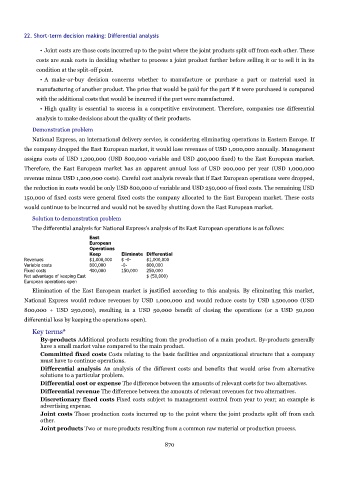Page 869 - Accounting Principles (A Business Perspective)
P. 869
22. Short-term decision making: Differential analysis
• Joint costs are those costs incurred up to the point where the joint products split off from each other. These
costs are sunk costs in deciding whether to process a joint product further before selling it or to sell it in its
condition at the split-off point.
• A make-or-buy decision concerns whether to manufacture or purchase a part or material used in
manufacturing of another product. The price that would be paid for the part if it were purchased is compared
with the additional costs that would be incurred if the part were manufactured.
• High quality is essential to success in a competitive environment. Therefore, companies use differential
analysis to make decisions about the quality of their products.
Demonstration problem
National Express, an international delivery service, is considering eliminating operations in Eastern Europe. If
the company dropped the East European market, it would lose revenues of USD 1,000,000 annually. Management
assigns costs of USD 1,200,000 (USD 800,000 variable and USD 400,000 fixed) to the East European market.
Therefore, the East European market has an apparent annual loss of USD 200,000 per year (USD 1,000,000
revenue minus USD 1,200,000 costs). Careful cost analysis reveals that if East European operations were dropped,
the reduction in costs would be only USD 800,000 of variable and USD 250,000 of fixed costs. The remaining USD
150,000 of fixed costs were general fixed costs the company allocated to the East European market. These costs
would continue to be incurred and would not be saved by shutting down the East European market.
Solution to demonstration problem
The differential analysis for National Express's analysis of its East European operations is as follows:
East
European
Operations
Keep Eliminate Differential
Revenues $1,000,000 $ -0- $1,000,000
Variable costs 800,000 -0- 800,000
Fixed costs 400,000 150,000 250,000
Net advantage of keeping East $ (50,000)
European operations open
Elimination of the East European market is justified according to this analysis. By eliminating this market,
National Express would reduce revenues by USD 1,000,000 and would reduce costs by USD 1,500,000 (USD
800,000 + USD 250,000), resulting in a USD 50,000 benefit of closing the operations (or a USD 50,000
differential loss by keeping the operations open).
Key terms*
By-products Additional products resulting from the production of a main product. By-products generally
have a small market value compared to the main product.
Committed fixed costs Costs relating to the basic facilities and organizational structure that a company
must have to continue operations.
Differential analysis An analysis of the different costs and benefits that would arise from alternative
solutions to a particular problem.
Differential cost or expense The difference between the amounts of relevant costs for two alternatives.
Differential revenue The difference between the amounts of relevant revenues for two alternatives.
Discretionary fixed costs Fixed costs subject to management control from year to year; an example is
advertising expense.
Joint costs Those production costs incurred up to the point where the joint products split off from each
other.
Joint products Two or more products resulting from a common raw material or production process.
870

